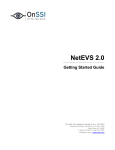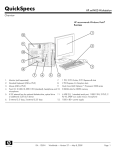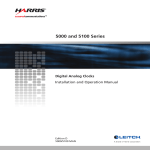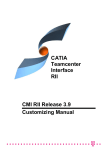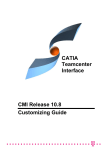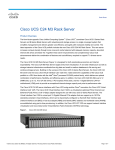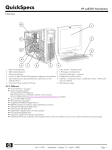Download "user manual"
Transcript
HP recommends Windows Vista® Business HP xw9400 Workstation Frequently Asked Questions July 2009 Index What’s new ................................................................................................................................... 2 Basics........................................................................................................................................... 2 Liquid Cooling................................................................................................................................ 4 Dual PCI Express x16 graphics and I/O ............................................................................................. 5 Memory ........................................................................................................................................ 6 HyperTransport .............................................................................................................................. 6 Chassis design ............................................................................................................................... 7 Operating systems .......................................................................................................................... 7 Linux ............................................................................................................................................ 8 ISV certifications ........................................................................................................................... 11 Manageability.............................................................................................................................. 13 Options and modules .................................................................................................................... 13 Warranty and support ................................................................................................................... 14 HP recommends Windows Vista® Business What’s new Q. What’s new with the HP xw9400 Workstation? A. The HP xw9400 is now available with 12 processor cores. To help meet the need for greater compute parallelism, the HP xw9400 now supports the AMD "Istanbul" 6-core processors. These processors are based on AMD's 45nm technology and represent the first six-core processors available for workstations. Basics Q. Why does HP offer two high-end workstations? A. The ultimate visualization performance of the HP xw9400 Workstation is designed to integrate and enhance today’s leading edge technology in a platform that is highly expandable, highly reliable and tuned for use on the applications you work with. Having the HP xw9400 Workstation in the HP line of Personal Workstations allows you to choose the architecture that best suits your requirements and price point. Q. How does the HP xw9400 differ from the HP xw8600? A. HP xw8600 Workstation Operating system Genuine Windows Vista® Business 32-bit with downgrade to Windows® XP Professional 32-bit custom installed* Genuine Windows Vista® Business 64-bit with downgrade to Windows® XP Professional x64 custom installed* Red Hat Enterprise Linux® WS 5 64-bit HP Installer Kit for Linux (includes drivers for both 32-bit and 64-bit OS versions of Red Hat Enterprise Linux® WS4 and WS5) HP xw9400 Workstation Genuine Windows Vista® Business 32-bit with downgrade to Windows® XP Professional 32-bit custom installed* Genuine Windows Vista® Business 64-bit with downgrade to Windows® XP Professional x64 custom installed* Genuine Windows Vista® Business 32-bit** Genuine Windows Vista® Business 64-bit** HP Installer Kit for Linux (includes drivers for both 32-bit and 64-bit OS versions of Red Hat Enterprise Linux WS4 and WS5) *Certain Windows Vista product features require advanced or additional hardware. See www.microsoft.com/windowsvista/getready/hardwarereqs.mspx and www.microsoft.com/windowsvista/getready/capable.mspx for details. Windows Vista Upgrade Advisor can help you determine which features of Windows Vista will run on your computer. To download the tool, visit www.windowsvista.com/upgradeadvisor. Windows Vista Business disk may also be included for future upgrade if desired. **To qualify for this downgrade an end user must be a business (including governmental or educational institutions) and is expected to order at least 25 customer systems with the same custom image. 2 HP recommends Windows Vista® Business (continued from previous) Processor Chipset Front Side Bus Ports Dual-Core* Intel® Xeon® 5200 Sequence Processors Quad-Core Intel® Xeon® 5400 Sequence Processors Up to 150W *Six-core, quad- and dual-core are new technologies designed to improve performance of multithreaded software products and hardwareaware multitasking operating systems and may require appropriate operating system software for full benefits; check with software provider to determine suitability; Not all customers or software applications will necessarily benefit from use of these technologies. **AMD’s numbering is not a measurement of clock speed. Intel® 5400 NVIDIA nForce Professional 3600 and NVIDIA nForce Professional 3050 1066 MHz FSB 1333 MHz FSB 1600 MHz FSB Front: 2 USB 2.0 1 IEEE 1394 1 Microphone In 1 IEEE 1394 Rear: 5 USB 2.0 1 IEEE 1394 1 Serial 2 PS/2 2 RJ-45 (NIC) 1 Audio In 1 Audio Out 1 Microphone In Internal: 1 USB 2.0 Slots Dual- ,Quad- and Six-Core* AMD Opteron™ 2000 Series** Processors 7 slots 2 PCIe X16 graphics 2 PCIe X8 mechanically (x4 electrical) 1 PCIe x8 (switchable as x1 or x8) 1 PCI-X 133MHz slot 1 legacy PCI slot Memory DDR2 FBD 667 ECC registered 16 DIMM (128 GB max) Network*** Dual integrated Broadcom 5755 Gigabit LAN on Motherboard Optional Broadcom 5751 NetXtreme Gigabit PCIe NIC 1 GHz HyperTransport Front: 2 USB 2.0 1 IEEE 1394 1 Microphone In 1 Audio Out Rear: 6 USB 2.0 1 IEEE 1394 1 Serial 2 PS/2 2 RJ-45 (NIC) 1 Audio In 1 Audio Out 1 Microphone In Internal: 2 USB 2.0 7 slots 2 PCIe x16 graphics 2 PCIe x16 mechanically (x8 electrically) 2 full-height PCI-X slots at 100 MHz, or 1 slot at 133 MHz, exclusive 1 full length PCI Dual channel DDR2-667 w/ Direct Connect Architecture 8 DIMM (64 GB max Dual Integrated NVIDIA (nForce Pro 3600) Gigabit LAN Dual NVIDIA Gigabit LAN-OnMotherboard Optional Broadcom 5751 NetXtreme Gigabit PCIe NIC ***The term “10/100/1000” or “Gigabit” Ethernet indicates compliance with IEEE standard 802.3ab for Gigabit Ethernet, and does not connote actual operating speed of 1 Gb/sec. For high speed transmission, connection to a Gigabit Ethernet server and network infrastructure is required. 3 HP recommends Windows Vista® Business Q. Who will benefit from the new HP xw9400 Workstation? A. The primary markets addressed by the HP xw9400 are Oil and Gas, CAE, Scientific, DCC, MCAD, Software Development, Defense, Life Sciences, and Higher Education/Research. In general, the HP xw9400 is for: • • • • • • • • • Users who require professional 3D graphics in compute intensive environments A small business or enterprise workgroup with demanding dual-processing needs and the highest performance Users who have data sets with performance that is extremely bandwidth and/or latency-dependent Users who need multiple slots of high-performance I/O and memory for inexpensive large memory and drive configurations Users who need large internal storage and backup Users who require high bandwidth external SAS connect Administrators looking for an easy, flexible deployment Administrators who require easy maintenance and serviceability Administrators who want simple remote management Q. Will I have to change my golden image on the new HP xw9400 Workstation? A. Yes, the new HP xw9400 is a completely new platform based on new technology from AMD and NVIDIA. Most of the system drivers are different than those used on previous HP Personal Workstations, therefore you will have to create new golden images. The standard suite of manageability software is available to help with the image building process. Liquid Cooling Q. Why did HP choose to implement Liquid Cooling? A. HP places a large priority on satisfying customer requirements. Achieving the lowest acoustics levels is a priority for HP Workstations. HP implements Liquid Cooling in a "holistic" fashion across both processors. Implementing Liquid Cooling in the HP xw9400 Workstation provides extremely efficient heat removal from the processors and allows the fans to run at greatly reduced RPMs, to help reduce acoustic output levels. Configurations where the processor fans are not the dominate noise source will not benefit from liquid cooling. Examples of possible configurations where processors are not the dominate noise source are 4 GB or 8 GB fully loaded memory configurations or configurations with 15K SAS drives. Q. How do I order Liquid Cooling? A. Liquid Cooling is a Configure-to-Order option. This provides you with a choice between Air Cooling and Liquid Cooling. Q. Where can I learn more about HP’s Liquid Cooling on the HP xw9400? A. Find additional information on the HP xw9400’s Liquid Cooling option in the "Reducing Acoustical Noise in Personal Workstations by Increasing Cooling Efficiency" whitepaper found at: www.hp.com/go/wswhitepapers additional information can be found at: http://h20331.www2.hp.com/Hpsub/cache/459889-0-0-225-121.html 4 HP recommends Windows Vista® Business Dual PCI Express x16 graphics and I/O Q. Graphically, what is special with the HP xw9400 Workstation? A. The HP xw9400 employs multiple new technologies to achieve peak graphics performance on two 3D graphics cards driving up to four 3D displays simultaneously or using SLI Technology to drive a single display at increased performance. The HP xw9400 Workstation combines proven HP Workstation engineering with AMD Opteron processor and NVIDIA nForce Professional chipset technologies. This gives the HP xw9400 the capability of supporting uncompromised dual PCI Express x16 (“by sixteen”) channels—something no other workstation can currently provide. Q. Is the second PCI Express slot a true x16 slot? A. Yes. Unlike some other solutions available today, the HP xw9400 Workstation does have two full performance x16 slots for uncompromised graphics performance. Q. Does the PCI Express channel deliver any advantage beyond accommodating two graphics cards? A. Yes. The PCI Express channels may be used for any device that is able to take advantage of the PCI Express interface. Q. What is meant by PCI Express (PCIe)? A. PCIe is the latest generation of PCI architecture. PCI Express is a radically new implementation of the PCI computer bus that uses existing PCI programming concepts and communications standards, but is based on a much faster serial communications system. PCI Express x16 slots provides up to eight times the aggregate bandwidth of a PCI-X 133 MHz 64-bit slot (8 GB/s bidirectional). Q. What's the advantage of PCI Express for graphics? What are the differences? A. PCI Express is the next generation interface not only for graphics cards, but also for I/O cards. PCI Express is a scalable interface, and depending on the chipset the system can have multiple PCI Express connections with various bandwidths. For graphics cards, the defined standard is "by sixteen" (or x16). This implementation of PCI Express provides twice the unidirectional bandwidth and four times the peak bandwidth as AGP 8X. The PCI Express specification also allows for 75W from the motherboard to the graphics cards. This is three times as much power as the standard AGP 8X specification. Q. What graphics cards are available on the new HP xw9400 Workstation? A. Professional 2D NVIDIA Quadro NVS 295 (256 MB) and NVIDIA Quadro NVS 290 (256 MB) Entry 3D NVIDIA Quadro FX 580 (512 MB) and NVIDIA Quadro FX 570 (256 MB) Mid-range 3D NVIDIA Quadro FX 1800 (768 MB) and NVIDIA Quadro FX 1700 (512 MB) High-end 3D NVIDIA Quadro FX 3700 (512 MB) NVIDIA Quadro FX 3800 (1 GB), NVIDIA Quadro FX 4800 (1.5 GB) NVIDIA Quadro CX (1.5 GB) NVIDIA Quadro FX 5600 (1.5 GB) NVIDIA Quadro FX 5800 (4 GB) ATI V7750 (1GB) 5 HP recommends Windows Vista® Business Q. What is NVIDIA SLI Technology? A. Scalable Link Interface, better known as SLI, allows custom high-performance graphics solutions, such as parallel rendering and composition, even if a single display is used. SLI effectively bands two NVIDIA PCI Express graphics cards together and allows them to work in parallel to provide higher levels of graphics performance than is possible with a single card. Such a high level of graphics performance is a new capability for workstations and is applicable in all high-end graphics applications such as interactive imaging and CAD. Q. Which graphics cards are SLI ready? A. The high-end 3D NVIDIA Quadro FX 3700, FX 3800, FX 4800, CX, FX 5600, and FX 5800 are all NVIDIA SLI-capable. Q. How should I determine how much graphics memory I require? A. Graphics performance is dependant upon many factors, including the amount of video memory. Higher performing cards also include bigger and faster GPUs, more memory bandwidth, and tend to have more features like dual-link connectors and support for stereo. The higher performance graphics cards will also have more memory (and a higher price). A dual display configuration at 1920 x 1200 pixels will allocate about 70 MB for the frame buffer. The remaining graphics memory will be used to store textures, display lists (graphics data sent by your applications), and other data specific to graphics. If your application would benefit from more storage space for these items, then you should purchase a graphics card with more memory. Memory Q. The HP xw9400 Workstation implements AMD’s Direct Connect Architecture. What does this mean? A. The AMD Direct Connect Architecture addresses and helps eliminate the real challenges and bottlenecks of system architecture providing superior computing performance. With the AMD Opteron Direct Connect Architecture, the HP xw9400’s memory is connected directly to the CPU optimizing memory performance, the I/O is directly connected to the CPU helping balance throughput and enable expandable I/O and the CPUs are connected directly to CPUs allowing more Linear Symmetrical Multiprocessing. Q. What is the advantage of having the DDR memory controller integrated (on-chip)? A. The HP xw9400’s AMD Opteron processor integrates the memory controller on-chip, reducing memory latency. Reduced memory latency is important for applications that frequently miss cache (i.e. scatter-gather operations). In addition, the integrated memory controller strategy distributes the memory bandwidth across the processors, allowing the aggregate system memory bandwidth to double when the second processor is added. HyperTransport Q. The HP xw9400 delivers AMD HyperTransport™ technology. What is HyperTransport? A. HyperTransport technology is a high-speed, high-performance, low-latency point-to-point cache coherent link for integrated circuits. It provides a universal connection designed to reduce the number of buses within the system, provide a high-performance link for embedded applications, and enable highly scalable multiprocessing systems. HyperTransport is designed to enable the chips inside of the workstation and networking and communications devices to communicate with each other faster. The end result is a reduction in bottlenecks and increased performance. 6 HP recommends Windows Vista® Business Chassis design Q. What's special with the HP xw9400 Workstation's chassis? A. The HP xw9400 Workstation is housed in an intelligently designed chassis with tool-less access for servicing, upgrading, and maintenance. The HP xw9400 features circuitry that allows the fans to run quieter at lower speeds when the system is idle or running low-power applications. Also, the acoustic dampening hard drive rails minimize transmission of vibration from the hard drives into the chassis. This vibration isolation reduces system acoustics while protecting the hard drives from vibrations outside of the system. Operating systems Q. What Operating Systems are available on the new HP xw9400 Workstation? A. Genuine Windows Vista® Business 32-bit with downgrade to Windows® XP Professional 32bit custom installed* Genuine Windows Vista® Business 64-bit with downgrade to Windows® XP Professional x64 custom installed* Genuine Windows Vista® Business 32-bit** Genuine Windows Vista® Business 64-bit** HP Installer Kit for Linux (includes drivers for both 32-bit and 64-bit OS versions of Red Hat Enterprise Linux WS4 and WS5) *Certain Windows Vista product features require advanced or additional hardware. See www.microsoft.com/windowsvista/getready/hardwarereqs.mspx and www.microsoft.com/windowsvista/getready/capable.mspx for details. Windows Vista Upgrade Advisor can help you determine which features of Windows Vista will run on your computer. To download the tool, visit www.windowsvista.com/upgradeadvisor. Windows Vista Business disk may also be included for future upgrade if desired. **To qualify for this downgrade an end user must be a business (including governmental or educational institutions) and is expected to order at least 25 customer systems with the same custom image. Q. Is dual OS preload an option? A. Dual OS preload will not be offered due to restrictions of licensing agreements. Q. Is Microsoft Windows 2000 supported on the new HP xw9400 Workstations? A. Microsoft Windows 2000 is not supported on the new HP xw9400. Microsoft discontinued OEM sales of Windows 2000 on March 31, 2004. Tier 1 OEMs, such as HP, can no longer ship systems with this OS. Q. Is Windows NT supported on the new HP xw9400? A. Microsoft discontinued OEM sales of Windows NT on June 30, 2002. Windows NT does not support many of the new technologies offered in the HP xw9400. Q. Will existing 32-bit OS software run, without being re-compiled, on an IA-32 processor with 64-bit extension technology? A. If you are running a 32-bit OS, yes. An IA-32 processor with 64-bit extension technology is 100% compatible with existing 32-bit applications when running with an existing 32-bit OS. If you are running a 64-bit OS the Intel processor supports “compatibility” mode, where all 7 HP recommends Windows Vista® Business 32-bit applications will continue to run under a 64-bit OS without being modified or recompiled. Linux Q. Will the HP xw9400 Workstation support Linux? A. Yes. Red Hat WS 3, Red Hat Enterprise WS 4 and the HP Installer Kit for Linux will be available. Q. What is the HP Installer Kit for Linux? A. The HP Installer Kit for Linux is a set of HP provided CD’s to be used in conjunction with a Red Hat Enterprise Linux installation to complete your Linux workstation installation. The CDs in the HPIKL are: • HP Driver CD for Red Hat Enterprise Linux WS 3 and 4. This is a “post install” CD used at the end of a Red Hat Enterprise Linux installation which contains HP content for your Linux workstation. Content provided includes: NVIDIA and ATI accelerated graphics drivers that have passed HP quality standards and are compatible with the hardware platform and RHEL releases. HP Documentation links Additional hardware drivers provided by HP that are not part of the standard Red Hat Enterprise Linux releases. All content provided on this CD is compatible with both RHEL WS 3 and RHEL WS 4. • Red Hat Driver Disk – for a specific Red Hat Enterprise Linux Update This is the ”RED” CD and is not included in ALL versions of the HPIKL. It will be included with the HPIKL when a hardware driver is required for the workstation platform that has not yet become a part of a standard Red Hat Enterprise Linux release. The next subsequent Update from Red Hat removes the need for this CD. For information on how to use the HP Driver CD or the Red Hat Driver Disk, refer to the HP Linux Workstation User manual at http://www.hp.com/support/linux_user_manual (See chapters 1-3). Q. Does the HP Installer Kit for Linux actually contain the Red Hat Box OS? A. No, you must obtain the Red Hat Box Set OS of your choice. The HP Installer Kit for Linux is a CD set to be used in conjunction with a RHEL install and supports both Red Hat Enterprise WS 3 or 4 OS. Red Hat requires that you purchase Red Hat Enterprise WS 3 or 4. It is available from HP as After Market Option (AMO) kits. Q. HP is only offering a preload of RHEL WS 4 (64 bit). What if I want to run the 32 bit OS instead? A. Included with the preloaded RHEL WS 4 workstation is a Red Hat Network registration card. Use this card to register your workstation with the Red Hat Network. This enables you to download all versions of Red Hat Enterprise Linux WS 3 or 4 for your workstation, and get any future updates from Red Hat as well. You can choose the 32-bit OS instead of the 64-bit OS if desired. Note: See the detailed hardware support matrix at 8 HP recommends Windows Vista® Business http://www.hp.com/support/linux_user_manual for clarification of what minimum Red Hat release/update is required for Red Hat Enterprise Linux to functional correctly on your workstation platform. Q. Will I get recovery CD’s with my preloaded Linux workstation? A. The OS delivery model for Red Hat Enterprise Linux is electronic. This is because of the Red Hat Network that Red Hat uses to continually provide updates for their customers for their operating system releases. As a result HP has found that creating a set of OS installation CDs has limited value. Many workstation owners quickly want to register to the Red Hat Network and obtain newer OS versions or build their own custom golden image. So instead HP is including the OS install CDs as ISO images on a hard disk drive partition. You can choose to create install CDs from the ISO images if you prefers. Or you can get them from the Red Hat Network as well. Q. What value does HP bring to Linux on Personal Workstations? A. • • • • • • Q. HP has a dedicated Linux R&D team with 25+ years of experience in OS and driver development HP provides an engineered solution of Red Hat Linux HP provides a single point of support (for warranty and extended software support services) HP has close relationship with multiple third-parties to enable the complete Linux workstation solution HP engineering provides extensive pre-sales technical support HP publishes detailed documents, drivers, and white papers on the support website regarding Linux on HP Workstations. Why would I choose Linux on HP Workstations? A. • • • • • • HP Workstations deliver ROI-based solutions on industry standard platforms. HP partners with customers and key technology providers to deliver an HP engineered Linux workstation you can deploy quickly and with confidence. HP Workstations offer worry-free deployment through HP worldwide service and support HP accountability and indemnification HP Workstations offers on-line technical white papers, drivers, and customer advisories enabling you to support yourself more easily. Q. Why is HP supporting Linux on workstations? A. Some of HP's technical workstation markets and customers rely on the UNIX operating environment, both in their infrastructure and the applications that they use. Linux on HP Personal Workstations is a very viable and attractive UNIX alternative. In addition, many OEMs are turning to Linux as a cost effective open source operating system for many different applications. This is especially true in the DCC, EDA, oil and gas, OEM, and some MCAD markets. Offering HP Workstations with Linux is part of HP's overall multi-OS strategy which provides HP-UX, Linux and Windows solutions to you. 9 HP recommends Windows Vista® Business Q. Where can I find (in detail) what workstation hardware is supported by Red Hat Linux? A. At http://www.hp.com/support/linux_hardware_matrix is a detailed hardware support matrix that is kept up to date every month with the latest support information for hardware platforms and their components. This matrix will indicate the minimum RHEL update version required for the workstation platform to operate correctly. As well it will indicate what add-in components are supported by RHEL. Q. Where can I find technical information to guide my installation, configuring, or customizing of my Linux workstation solution? A. At http://www.hp.com/support/linux_user_manual under "setup, install, and configure" you will find multiple white papers on Linux configuration tips such as enabling large memory configurations, hyper threading, multi-headed graphics configurations, and release notes for each Red Hat Enterprise Linux Update. Q. Will Linux distributions other than Red Hat work on HP Workstations? A. Most likely they will work. However HP warranty support is only available for the Red Hat distribution. In addition HP has reviewed the performance, functionality, and reliability of the Red Hat distribution on the hardware platform and made any required adjustments. At http://www.hp.com/support/linux_hardware_matrix you can find a detailed hardware support matrix that is kept up to date every month with the latest support information for hardware platforms and their components. Q. What is HP's Linux strategy in the future? A. HP Workstations are continually evaluating market trends along with customer requirements to determine solutions that best meet customer needs. HP’s corporate strategy is strategic relationships with both Red Hat and Novell/SUSE and many of HP’s products offer both Red Hat and SuSE distributions. Q. What does the future hold for HP and Linux? A. HP simplifies the integration of open source and Linux! Our solutions are built with best-ofbreed software from our industry leading partners, complemented by HP value-add in areas like management and high availability clustering, implemented on market-leading standardsbased platforms, and supported by HP Services worldwide. Known for its performance, scalability, reliability and low cost, Linux is proving to be the answer for workstation environments that were in the past traditionally a proprietary UNIX infrastructure. Such markets as Digital Content Creation (DCC), oil and gas, EDA, MCAD, and software development areas are adopting and using Linux in their infrastructures. Q. Why doesn't HP offer a dual boot with Windows and Linux? A. HP cannot offer dual boots due to licensing agreements. Q. What version of Red Hat Linux supports 64-bit? A. Red Hat Enterprise Linux WS3 and WS4 (RHEL WS3 and WS4) has both a 32-bit version and a 64-bit version. HP will preinstall the 64-bit version of RHEL WS4 and will also support the 32- and 64-bit versions with a Driver CD in the HP Installer Kit for Linux. Are there other 64-bit distributions of Linux that will work on the HP Workstations? A. It is very likely that other Linux distributions will work. However Red Hat Enterprise Linux is the distribution HP is choosing to do a full engineering evaluation and support for our customers. 10 HP recommends Windows Vista® Business Q. Can I run 32-bit apps on a 64-bit Linux OS? How does this work? A. Yes, you can run 32-bit apps on 64-bit Linux OS as the runtime support (mainly shared libraries) for the application exists on the system. The Linux convention for having 32-bit libraries and 64-bit libraries on the same OS is to have companion library directories. The 32-bit libraries are in the conventional locations…. /lib, /usr/lib, /usr/X11R6/lib, etc whereas 64-bit libraries just append 64 to the directory name such as /lib64, /usr/lib64, and /usr/X11R6/lib64. This also includes 32-bit versions of the graphics libraries which HP has included from the graphics vendors. Q. What do I do if my 32-bit apps do not run due to missing shared libraries? A. You will need to get the library from Red Hat's 32-bit RHEL 3 distribution and put it on your system in the appropriate directory and report the missing library to Red Hat through their Red Hat Network subscription. This will help Red Hat to get the right set of 32-bit libraries needed for most apps in future releases. Q. Once I have installed the 64-bit version of Linux, what do I have to do to build 64-bit apps? A. Simple. Just rebuild from scratch and the compiler will build 64-bit by default. This is true for most apps. However, some apps must be made 64-bit clean which means that the developers must review the code to get rid of any assumptions about 32-bitness, such pointer arithmetic issues. Some makefiles that explicitly declare paths such as /lib, /usr/lib and /usr/X11R6/lib might need to be changed to append "64." ISV certifications HP has very strong relationships with Independent Software Vendors (ISVs). The software vendors recognize that HP is a critical partner in the industry, not only as a hardware OEM, but as a marketing and support partner. HP, in some cases, has engineering personnel located full-time on site at these software vendors' location providing technical support, application performance tuning, and graphics driver optimization. ISV certification is a critical aspect of the workstation value proposition. Workstation customers are running very complicated, high-end, technical applications and reliability and stability are an absolute requirement. The entry workstation is targeted at specific technical applications, many of which were listed above. The following table outlines the applications that are planned for the HP xw9400. Some of the applications listed in the table do not certify hardware, but they are listed as "targeted" applications. For those applications listed above that do offer hardware certification, the new entry workstation will be certified. Oil and gas CAE DCC MCAD Integraph GeoMedia MSC MSC Patran Adobe Photoshop Premiere Pro After Effects Encore DVD Bentley MicroStation Landmark GeoGraphix GeoProbe Viz, Interp, and Modeling Apps AutoDesk 3D Studio Max Maya EDS GoCAD Paradigm Geo Viz, Inerp, and Earth Canopus EDIUS HD ICEM ICEM Surf 11 HP recommends Windows Vista® Business Model (including VoxelGeo) Roxar RMS Schlumberger Petrel Workflow Tools Shell 123D1 NX Leitch VelocityHD VelocityQ SolidWorks SolidWorks SolidWorks SolidWorks (x 64) SolidWorks SolidWorks (x 64) 2005 2006 2006 2007 2007 UGS IDEAS 11 IDEAS 12 TeamCenter Visualization 2005 TeamCenter Visualization 2005 (x 64) TeamCenter Visualization 5.0 TeamCenter Visualization 5.1 Unigraphics NX3 Unigraphics NX4 Unigraphics NX4 (x 64) SMT Kingdom Suite 12 HP recommends Windows Vista® Business Manageability Q. What manageability features are available on HP Personal Workstations *? A. HP Client Management Solutions help you simplify management of our workstations and reduce total ownership costs. These integrated solutions are a result of extensive work between HP and its partner, Altiris, a leading provider of manageability solutions. HP Client Manager Software is a free of charge download available with all HP Personal Workstations. It allows you to centrally track, monitor, and manage the hardware aspects of HP client systems on your network. Other benefits include: • Ability to get valuable hardware information such as CPU, memory, video, and security settings • Monitor system health to fix problems before they occur • Install drivers and BIOS updates without visiting each workstation • Remotely configure BIOS and security settings • Automate processes to quickly resolve hardware problems • Local recovery *Available on Microsoft Windows-based systems. Q. What is the HP Performance Tuning Framework*? A. The HP Performance Tuning Framework is a preloaded utility which enables the most favorable configuration of HP Personal Workstations delivering stability and best performance. The Framework will guide your system setup, allowing a "custom" configuration that best matches the workstation to user requirements. This customization facilitates availability of the latest graphics cards and drivers and removes some memory restraints. The Framework's extensible design permits new configuration functionality and application support to be easily integrated over time. To facilitate the delivery of such new features, the Framework automatically updates itself when newer versions become available. The Performance Tuning Framework, available only from HP, can help save both time and money and increase overall productivity. For more information on the HP Performance Tuning Framework, go to: http://www.hp.com/go/framework *Available on Microsoft Windows-based systems. Options and modules Q. What options are available for the new HP xw9400 Workstation? A. For a complete list of all options for the HP Workstations, please go to: http://www.hp.com/workstations/pws/options. 13 HP recommends Windows Vista® Business Warranty and support Q. What is the warranty and support for HP Workstations with Windows? A. The standard warranty for the HP Personal Workstations is 3-3-3 (three years parts, three years labor, and three years next business day on-site).* *Service levels and response times for HP Care Packs may vary depending on your geographic location. Restrictions and limitations apply. For details, visit http://ww.hp.com/go/carepack. Q. What is the warranty and support for HP Workstations with Linux? A. The warranty for HP Workstations with Linux is the standard 3-3-3 with 90 days of OS configuration and installation assistance. Q. Will HP stand behind Linux when I have problems? A. HP is the first place for support. Hardware and software warranties for the workstations with Linux will be the same as that of the Windows workstations. Extended hardware warranties and software support options will also be available for purchase for if you need extended coverage. Page 1 image Screen image courtesy of DreamWorks Animation SKG. © 2008-2009 Hewlett-Packard Development Company, L.P. The information contained herein is subject to change without notice. The only warranties for HP products and services are set forth in the express warranty statements accompanying such products and services. Nothing herein should be construed as constituting an additional warranty. HP shall not be liable for technical or editorial errors or omissions contained herein. Opteron is a trademark of Advanced Micro Devices, Inc. HyperTransport is a licensed trademark of the HyperTransport Technology Consortium. Microsoft, Windows, and Windows Vista are trademarks of the Microsoft group of companies. July 2009 14














